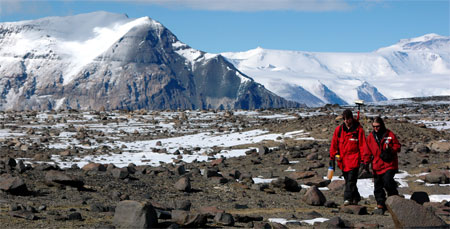|
Planning for the futureRevised policies and maps ensure environmental protection of Dry ValleysPosted September 9, 2011
There are few places in Antarctica as heavily researched as the McMurdo Dry Valleys The 15,000-square-kilometer area now boasts the most comprehensive environmental management plan under the Antarctic Treaty “The primary purpose of a management plan is to protect the values that are specific to a particular area,” Biletnikoff said. “There are many exceptional scientific values to protect in this area, not to mention the intrinsic value of this natural wilderness area. There is much to consider: our helo activities, our logistics activities, our field-camp management activities, and our science activities.” RPSC is the prime contractor to the National Science Foundation (NSF) The Protocol on Environmental Protection to the Antarctic Treaty The McMurdo Dry Valleys, under the environmental protection system, was one of the first sites to become an Antarctic Specially Managed Area (ASMA) The revised management plan for the Dry Valleys ASMA was presented to a forum of the Antarctic Treaty members earlier this summer in Buenos Aires, an annual gathering known as the Antarctic Treaty Consultative Meeting (ATCM) The revised management plan not only refines the various zones defined within the ASMA, but it includes a new set of maps made from high-resolution satellite imagery that serves to better protect the environment thanks to improved accuracy. “The maps are highly accurate compared to the maps we had for the previous management plan,” Biletnikoff said, referring to an older set of U.S. Geological Survey maps. 
Photo Credit: Nate Biletnikoff/Antarctic Photo Library
Surveyor Jeff Scanniello uses a high-precision GPS to help geo-reference a satellite map of the McMurdo Dry Valleys.
RPSC worked with subcontractor Environmental Research & Assessment (ERA) “We re-baselined exactly what our current environmental footprint is, so we can accurately assess potential changes to footprint in the future, as part of the decision-making process,” he added. The work was conducted in collaboration with Antarctica New Zealand In addition, the Polar Geospatial Center (PGC) “I wholeheartedly believe that this is the most detailed plan to date [for an ASMA],” Biletnikoff said.1 2 Next |



For USAP Participants |
For The Public |
For Researchers and EducatorsContact UsNational Science FoundationOffice of Polar Programs Geosciences Directorate 2415 Eisenhower Avenue, Suite W7100 Alexandria, VA 22314 Sign up for the NSF Office of Polar Programs newsletter and events. Feedback Form |



